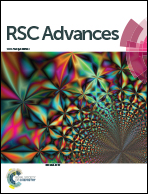Spatially-controlled growth of platinum on gold nanorods with tailoring plasmonic and catalytic properties†
Abstract
We describe the synthesis of bimetallic dendritic platinum decorated gold nanorods (AuNRs) by the spatial control of Pt growth over gold nanorods using a heterogeneous seed-mediated growth method. The amounts of the Au seed and Pt-precursor were changed to achieve a tunable volume fraction of Pt coverage on the Au NRs surface. Pt nanostructures were spatially separated from each other, which was highly favorable for promising optical and catalytic properties. The dendritic-Pt decorated AuNRs with variable Au/Pt ratios were exploited to study their surface plasmonic properties and catalytic activities. Interestingly, the Pt decorated AuNRs showed strong surface plasmon resonance (SPR) peak due to noncompact dendritic Pt shell in contrast to the conventional core–shell Au@Pt nanoparticles (NPs). Moreover, the longitudinal peak of the AuNRs was finely tuned from 820 to 950 nm (NIR region) by controlling the volume fraction of the Pt decoration over the AuNRs. The catalytic activity of the dendritic-Pt decorated AuNRs on the reduction of 4-nitrophenol (4-NP) by sodium borohydride (NaBH4) as reducing agent was studied and found to be superior to the activities compared to the monometallic Au NRs. Considering practical applications, dendritic-Pt decorated AuNRs nanostructures were immobilized successfully on the hydrophilic polyvinylidene difluoride (PVDF) film as an efficient reusable catalyst.


 Please wait while we load your content...
Please wait while we load your content...